

More tales of the Kalitta wedge
I received a lot of great feedback from Friday's column about Connie Kalitta's wreck at the 1971 U.S. Nationals in Robert "Poncho" Rendon's wedge Top Fueler. Despite some effort, I was not able to talk to Kalitta about it, but I did receive a ton of great information from unexpected places. Actually, with the power and reach of this column, I guess I shouldn’t say "unexpected" anymore because you guys continue to amaze me with not only your willingness to contribute but also your resources.
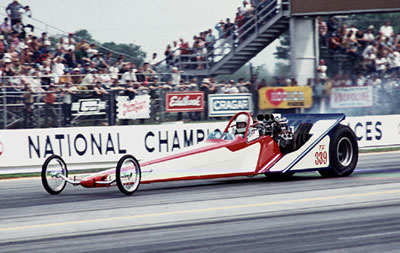 |
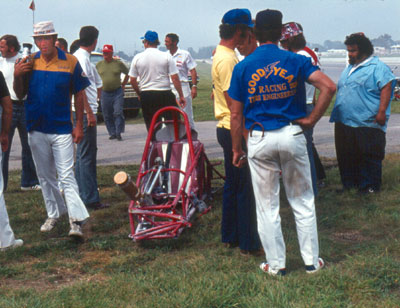 |
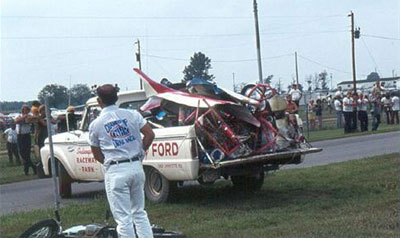 |
One of the first people I heard from was my old buddy and photographer Tom Schiltz, who sent these photos of the wedge on what may have been its maiden (and only) voyage. I actually received the first two photos from a couple of folks, meaning that they're floating around cyberspace, but Schiltz, a longtime National DRAGSTER contributor, is actually the guy who shot them. The first one shows the car launching on the ill-fated pass – the only photo of the car I've seen in action – and the second shows what remains of the chassis and roll cage that carried Kalitta to a surprisingly safe stop given the severity of the accident.
Interestingly, Schiltz could have found himself in the middle of the maelstrom had it not been for Ron Rickman (who gained fame by being the guy hiding behind the scoreboard post as Kalitta's mount veered out of control).
"I finished shooting from the top end and was walking down the return road toward the starting line," relayed Schiltz. "I stopped to talk to Ron Rickman, and when they fired Top Fuel, he told me I had to move back to the return road, so I kept walking toward the line. I shot the launch and saw the car go over on its side, so I kept shooting and winding. I had no motor drive, so I wound as fast as I could. I was able to hitch a ride back to the top end and get the parts and pieces photos."
What's interesting about the second photo is that it shows stunned car owner Rendon at far right and our own Leslie Lovett, in his blue and yellow ND uniform, at left. Lovett's toting his ubiquitous Hasselblad, chronicling the mess for NHRA.
Schiltz also sent the third photo, which shows the remains of the car being trucked away. I'd say that car was never going to run again.
Unable to reach Kalitta, I was very pleased to hear from other credible sources, including then partner Shirley Muldowney and her son, John, who witnessed the accident, as well as Dennis Godsey, a crewmember for Kalitta during the event. It turns out that Kalitta was not the car's regularly scheduled driver -- the late Gene Domagalski was slated to drive.
Remembered Godsey, "On Thursday, we had both [Funny Cars] in line and were near the head when Connie spotted 'Poncho' and Gene Domagalski coming to the front of the Top Fuel qualifying line. They were talking, and Connie told 'Poncho' he could get the car in the show and proceeded to climb in (he had never driven a rear-motor car). My belief is that in a front-motor car, you can be 15 to 20 percent sideways and see where you are, and in a rear-motor car, [at] that same percentage, you have lost control, which happened."
According to John Muldowney, Kalitta lost control of the car because the Detroit locker rear end came unlocked after Kalitta pedaled through tire shake, and the left rear tire stopped driving, bringing the car around to the left. Muldowney had left his mom in the Funny Car staging lanes – she was not at the top end, as the film Heart Like a Wheel depicts -- and had ridden his minibike down to the top end to watch the fuelers run and had an excellent vantage point just past the finish line, almost across from where Kalitta's shattered mount eventually skidded to a stop.
Godsey also remembered buckling a battered and bruised Kalitta into his Funny Car the following day after the wreck. "He about passed out," said Godsey.
Although I haven't been able to find out whether the crash happened on the car's maiden voyage or if it had been tested locally at a venue such as Detroit Dragway, William McLauchlan said that the car was built on a Logghe chassis and that Al Bergler did the bodywork, including the wedge. (Don Prudhomme's wedge was a Buttera car, and Leland Kolb's was a Woody car, according to McLauchlan, who thinks that the famed Nye Frank built the body on both.)
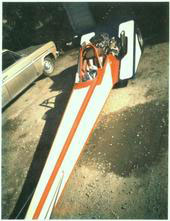 |
I also was surprised to hear from Anthony Tierney, the nephew of the late Rendon, who included this photo of the wedge outside of someone's shop.
" 'Poncho' Rendon is actually my great uncle, but he raised me as his son," wrote Tierney. "In my eyes, he didn't receive a lot of credit for the things he did within the sport. I saw your post about Rickman, and I thought this would be a great chance to keep his spirit alive. He was a real unsung hero of the pioneer days in drag racing that lived for the sport.
"Perspective can be a strange thing," he added. "By the time I was born in 1987, my uncle had already spent at least twice my current 22 years of age making cars go fast. And even though by the late '70s, much of his career in racing had already been committed to the history books, I felt then as I do now that his contribution to the sport of drag racing could not be measured in trophies. Like so many racers before him, he hung in the sport that had yet to find its mainstream appeal by sheer grit and determination and often under tough circumstances. I’m not sure that the racers of today understand the bond that the racers of his era forged with one another. I’m also not sure if people understand the uncanny knack that he and the other racers had for taking nothing seriously but the racing itself. Back then, crews were fleshed out by diehard drag racing volunteers, and the lines of responsibility were blurred — drivers, crew, and owners alike pitched in equally to get the car to the next round. I figure that among them there was a shared unspoken knowledge that they were a part of something much bigger than themselves. I also figure it was an experience that they wouldn’t trade a moment of.
"You might be wondering how someone who only lived those early days in racing vicariously can give such a personal perspective. To begin, my uncle had a gift for telling a story that made pictures form in your head of people, places, and events. He could tell any story rich with detail and side-splitting humor. The years I spent attending events rounded out my perspective as well. I met so many of the people he talked about and saw many of the places and events that he attended year after year. More than anything, though, it was drag racing itself that gave me a love of the sport and an understanding of that time far beyond the point of view one of my age would normally have. I’d love for my uncle’s efforts to be recounted in the people he touched and the number of friends he made. When he died, he was eulogized by none other than Shirley Muldowney. If you ask her, she will tell you in an even more compelling way that he was not only instrumental in her career, but more importantly, a man who could be as fierce a competitor as he was a friend."
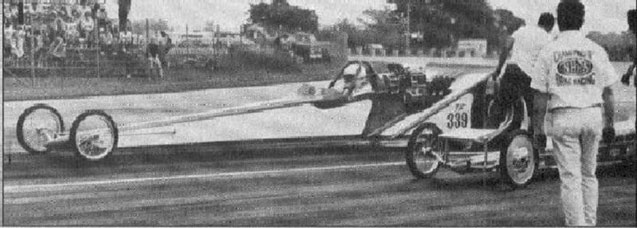 |
Tierney also directed me to a thread he'd started about his uncle on The H.A.M.B. message board, where I found this photo of the car. At first glance, it didn't look like Indy – there doesn’t appear to be a guardrail next to the car -- so maybe the car did get shaken down; on the other hand, the car is lettered with Kalitta's 339 permanent number (according to the WDIFL.com lists; he also had 399; Domagalski's number was 374), and that appears to be Kalitta in the car, based on the white helmet in the top photo. My bet is that this is Indy after all. (Which leads me to another question stuck in my mind: if Kalitta's was a spur-of-the-moment decision to drive the car, why does it carry his number? Did they stick it on in the lanes? If so, they did a mighty nice job. Hopefully I can get to Connie and get all of the answers.)
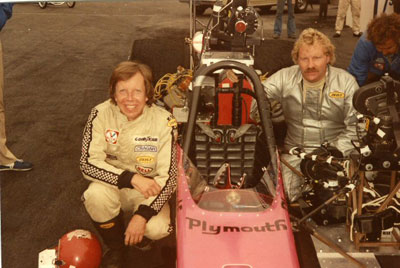 |
On a final side note, I mentioned with the Heart Like a Wheel clip that I showed here last week that "T.V. Tommy" Ivo and Kelly Brown were the stunt drivers for the film. Brown, the former NHRA Top Fuel champ, was driving the Kalitta car, and Ivo handled all of the work in Shirley's cars as well as the Don Garlits car in the crash clip.
"I was doing all of Shirley's car driving," said Ivo, pictured, left, with K.B. "I was the only one that could fit in her car. Of course, there was only a dummy in the [Kalitta] car when they crashed it. No, no, no -- I'm not calling Kelly a dummy --- it was a 'real' dummy in the car!!! <Ivo type grin>
"The first run I made with all these cameras on the car, it almost ran off the end of the track, it weighed so much. Running on alcohol, it was probably only running about 180, if that, but the car probably weighed twice as much. John Muldowney built all the mounts on the car for them."
According to Ivo, the wedge was attached to a tow cable that ran it and its dummy driver right into the guardrail from about 300 feet prior to the collision point.
OK, race fans, that's it for the day and, perhaps, the week. I'm traveling to Charlotte Thursday for the big four-wide bash. I missed the exhibition last September and didn't want to miss this deal in case it's the one and only time it happens. Between all of the hubbub there and travel, it may be next week before I have something new, but who knows …
Thanks again for your support and participation.



















































